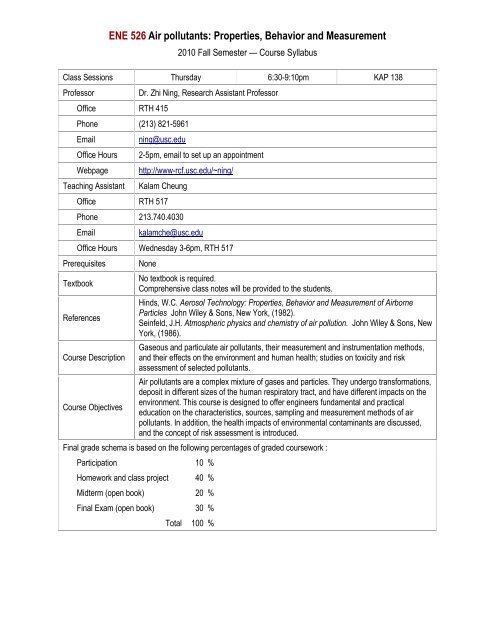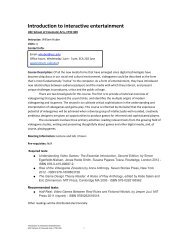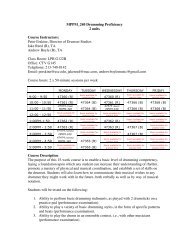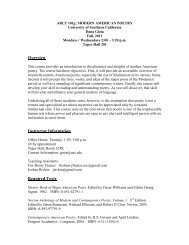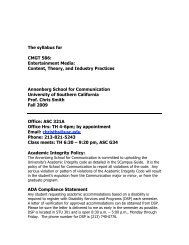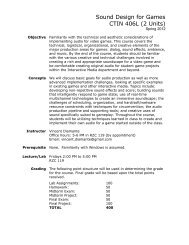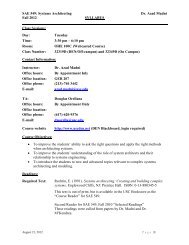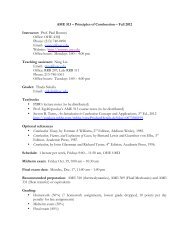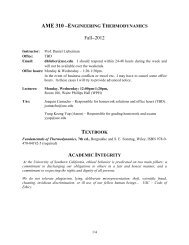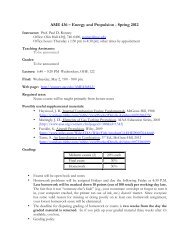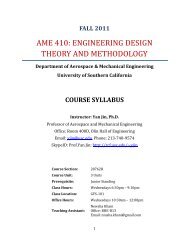Syllabus - ENE 428 – Introduction to Air Quality - USC Web Services
Syllabus - ENE 428 – Introduction to Air Quality - USC Web Services
Syllabus - ENE 428 – Introduction to Air Quality - USC Web Services
You also want an ePaper? Increase the reach of your titles
YUMPU automatically turns print PDFs into web optimized ePapers that Google loves.
<strong>ENE</strong> 526 <strong>Air</strong> pollutants: Properties, Behavior and Measurement<br />
2010 Fall Semester — Course <strong>Syllabus</strong><br />
Class Sessions Thursday 6:30-9:10pm KAP 138<br />
Professor Dr. Zhi Ning, Research Assistant Professor<br />
Office RTH 415<br />
Phone (213) 821-5961<br />
Email ning@usc.edu<br />
Office Hours 2-5pm, email <strong>to</strong> set up an appointment<br />
<strong>Web</strong>page http://www-rcf.usc.edu/~ning/<br />
Teaching Assistant Kalam Cheung<br />
Office RTH 517<br />
Phone 213.740.4030<br />
Email kalamche@usc.edu<br />
Office Hours Wednesday 3-6pm, RTH 517<br />
Prerequisites None<br />
Textbook<br />
References<br />
Course Description<br />
Course Objectives<br />
No textbook is required.<br />
Comprehensive class notes will be provided <strong>to</strong> the students.<br />
Hinds, W.C. Aerosol Technology: Properties, Behavior and Measurement of <strong>Air</strong>borne<br />
Particles John Wiley & Sons, New York, (1982).<br />
Seinfeld, J.H. Atmospheric physics and chemistry of air pollution. John Wiley & Sons, New<br />
York, (1986).<br />
Gaseous and particulate air pollutants, their measurement and instrumentation methods,<br />
and their effects on the environment and human health; studies on <strong>to</strong>xicity and risk<br />
assessment of selected pollutants.<br />
<strong>Air</strong> pollutants are a complex mixture of gases and particles. They undergo transformations,<br />
deposit in different sizes of the human respira<strong>to</strong>ry tract, and have different impacts on the<br />
environment. This course is designed <strong>to</strong> offer engineers fundamental and practical<br />
education on the characteristics, sources, sampling and measurement methods of air<br />
pollutants. In addition, the health impacts of environmental contaminants are discussed,<br />
and the concept of risk assessment is introduced.<br />
Final grade schema is based on the following percentages of graded coursework :<br />
Participation 10 %<br />
Homework and class project 40 %<br />
Midterm (open book) 20 %<br />
Final Exam (open book) 30 %<br />
Total 100 %
<strong>ENE</strong> 526 <strong>Air</strong> pollutants: Properties, Behavior and Measurement<br />
2010 Fall Semester — Course <strong>Syllabus</strong><br />
Class Schedule<br />
Class Meetings Weeks<br />
<strong>to</strong> cover<br />
Week THU <strong>to</strong>pics Topics<br />
Overview and <strong>Introduction</strong> <strong>to</strong> Exposure Assessment<br />
Assignments Due Dates<br />
1 8/26 1 This part includes a description of air pollutants, and an overview of exposure<br />
and risk assessment.<br />
2<br />
3<br />
9/2<br />
9/9<br />
2 Gaseous Pollutants<br />
Gas-phase pollutants, their characteristics and methods for their measurement<br />
are discussed in this section.<br />
4 9/16 3-4 Particulate Pollutants<br />
5 9/23<br />
Particulate pollution is discussed extensively in this session. The complexity of<br />
the nature of particulate pollutants makes it necessary <strong>to</strong> devote four lectures<br />
6 9/30<br />
on the subject.<br />
7 10/7<br />
8 10/14 1-2<br />
9 10/21<br />
10 10/28 1-2<br />
11 11/4<br />
12 11/11 1<br />
13 11/18 2<br />
The Atmosphere<br />
The role of the atmosphere as a medium for pollutant transport is discussed. A<br />
brief discussion on the Gaussian dispersion model is given. The use of<br />
compartmental models <strong>to</strong> describe the behavior of pollutants in an outdoor or<br />
indoor environment is presented. Point and line sources are discussed.<br />
Indoor <strong>Air</strong> Pollution<br />
This section will present the difference between outdoor, indoor and personal<br />
exposures. Sources of measurement errors will be discussed. Particular<br />
emphasis will be spent on pollutants partitioned between gas and particulate<br />
phases, which are difficult <strong>to</strong> sample properly.<br />
Respira<strong>to</strong>ry Deposition of Environmental Contaminants<br />
This section will discuss fundamental aspects of respira<strong>to</strong>ry deposition of<br />
particulate and gas phase pollutants. The role of the pollutants phase and<br />
chemical composition on the uptake and site of deposition in the respira<strong>to</strong>ry<br />
tract will be explained. Inhalable and respirable sampling strategies will be<br />
presented.<br />
Principles of Risk Assessment<br />
This section will begin with a discussion on hazard identification. EPA, NIOSH<br />
and IARC approaches for classification of carcinogens are reviewed. Dose<br />
response relationships and <strong>to</strong>xicity are discussed.<br />
The concepts of No-Effect Level and Low-Effect Level are presented.<br />
Approaches for extrapolating risk from animal <strong>to</strong> human will be covered. Risk<br />
assessment for non-carcinogens is also discussed. Case studies for specific<br />
<strong>to</strong>xic compounds will be presented in this section as examples.<br />
14 11/25 Thanksgiving Holiday <strong>–</strong> no class<br />
15 12/2 Principles of Risk Assessment (cont.)<br />
16 12/9 Final Exam
<strong>ENE</strong> 526 <strong>Air</strong> pollutants: Properties, Behavior and Measurement<br />
STATEMENT ON ACADEMIC INTEGRITY<br />
2010 Fall Semester — Course <strong>Syllabus</strong><br />
<strong>USC</strong> seeks <strong>to</strong> maintain an optimal learning environment. General principles of academic honesty include the concept<br />
of respect for the intellectual property of others, the expectation that individual work will be submitted unless<br />
otherwise allowed by an instruc<strong>to</strong>r, and the obligations both <strong>to</strong> protect one’s own academic work from misuse by<br />
others as well as <strong>to</strong> avoid using another’s work as one’s own.<br />
All students are expected <strong>to</strong> understand and abide by these principles. SCampus, the Student Guidebook, contains<br />
the Student Conduct Code in Section 11.00, while the recommended sanctions are located in Appendix A:<br />
http://www.usc.edu/dept/publications/SCAMPUS/gov/. Students will be referred <strong>to</strong> the Office of Student Judicial<br />
Affairs and Community Standards for further review, should there be any suspicion of academic dishonesty. The<br />
Review process can be found at: http://www.usc.edu/student-affairs/SJACS/.<br />
STATEMENT FOR STUDENTS WITH DISABILITIES<br />
Any student requesting academic accommodations based on a disability is required <strong>to</strong> register with Disability<br />
<strong>Services</strong> and Programs (DSP) each semester. A letter of verification for approved accommodations can be obtained<br />
from DSP. Please be sure the letter is delivered <strong>to</strong> me (or <strong>to</strong> TA) as early in the semester as possible.<br />
DSP Contact Information<br />
Office location: STU 301<br />
Hours open: 8:30 a.m. until 5:00 p.m. — Monday - Friday.<br />
Phone number: (213) 740-0776


